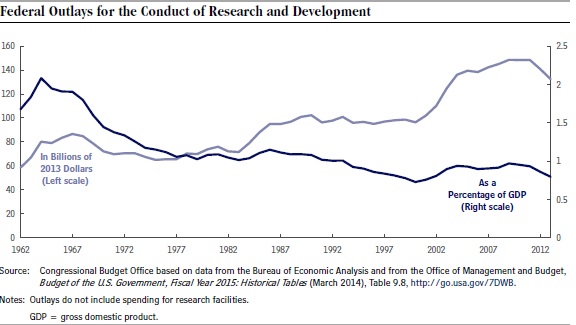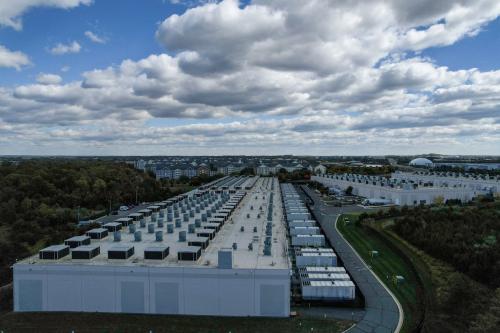Innovation serves as a key driver of growth in the economy. Innovative firms develop improved manufacturing processes and create new and less expensive products for consumers. For decades the Federal government has supported the growth of innovation through regulations and tax policy. A new report from the Congressional Budget Office provides insight into the challenges that it faces in its efforts to spur new innovations.
The Current State of Federal Funding for R&D

To better understand the effort put towards federal R&D it’s necessary to examine a few trends. In terms of 2013 dollars investments from the federal government have trended upward over time. Spending in this area has increased by more than 100 times from 1949 to 2013, rising from $940 million to $132 billion. However, the raw dollar figures obscure the actual size of the investment. In terms of a percentage of GDP, federal investments in R&D have waned over the years. Federal spending as a percent of GDP has decreased by more than half from a height of 1.92 percent in 1964 to 0.86 percent in 2013. Industry has picked up the slack of decreases in federal R&D expenditures. Non-federal R&D spending (almost entirely industry) now accounts for about 2 percent of GDP.
Policies to Promote Innovation
The CBO report suggests several policies that could help to increase innovation. Caps on discretionary spending currently place tight restrictions on the funding available for R&D. The rules shape how legislators make decisions about appropriations. In real dollars R&D spending is projected to stay relatively constant over the next 10 years but as the economy grows the levels of funding as a percentage of GDP will continue to shrink. This continued pressure could mean that the private sector would lack the capacity to “replace” these funds and the overall level of funding could decrease. To prevent this scenario changes to how Congress allocates R&D funding are needed.
The CBO report also suggests that the “transfer of individual inventions” from federal laboratories to the private sector is a strategy that could support innovation in the economy. The scientists and engineers who work at federal laboratories are experts in their fields and excel at developing new technologies. Technologies develop at federal laboratories account for roughly one third of innovative products. The private sector has greater experience with design, marketing, and other activities involved with creating a successful product.
A final proposal involves the federal government supporting new technologies by becoming their first customer. The government was one of the first organizations to uby computer circuits, which was a boon to the nascent industry. One virtue of this strategy is that it can help to bring down the price of expensive technology as firms ramp up production. This strategy is complicated by current budget politics. Such a strategy would require perhaps tens of billions in new spending. Even more damaging from a political perspective is that early products could have design flaws creating the perception of wasteful government spending.
Choosing the best policies to promote innovation is extremely difficult. Predicting which fields or organizers will be innovative is a perilous task that will result in failure more often than success. Thus throwing money at the problem is an inefficient strategy. Despite the complex risks involved with R&D investments there is a sense among experts that the federal government must adopt a more vigorous approach. Continued innovation was essential to the growth of the American economy over the past century. Further restrictions on federal R&D could represent a serious threat to that advantage.
Yikun Chi contributed to this post
The Brookings Institution is committed to quality, independence, and impact.
We are supported by a diverse array of funders. In line with our values and policies, each Brookings publication represents the sole views of its author(s).




Commentary
How The Federal Government Fosters Innovation
January 28, 2015